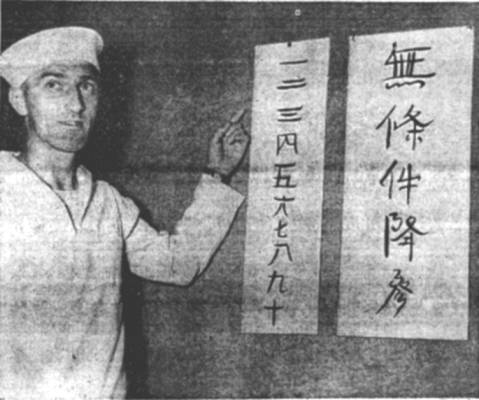SAMPSON
RECRUIT, ONCE PRISONER OF JAPS, WANTS CRACK AT 'EM
Has Burning Desire To
Repay Their 'Courtesies'
Naval Training
Station, Sampson
| It is a safe bet that any one of the thousands of
sailors here, from Capt. Harry A. Badt, USN, commandant, on down to the
rawest recruit, would give almost anything to be among the first to land
in Japan But for Apprentice Seaman Charles M. Williams,Brooklyn, it
would be the culmination of a burning desire to repay the Japs for the
'courtesies' shown him while he was their prisoner for more than six
months. It was at Hong Kong where Recruit Williams was taken prisoner on
Christmas Day, 1941, just 17 days after the Nipponese started their
invasion of the British Crown Colony.
Under Heavy Bombing
Williams, who was a junior officer at the Hong Kong branch of the
Chase National Bank of New York, said that the city and mainland
underwent incessant bombing before the English garrison and Canadian
contingent capitulated to the Nips. On one occasion, a bomb struck a
truck of coolies 50 yards from where he stood, killing all the
occupants. |

Charles
M. Williams, apprentice seaman at Sampson, points to the Nips' symbols
for "one, two, three, four" etc. in recalling that the little
yellow men made their captives, of whom he was one, count off each
morning in Japanese. The characters on the right stand for Mo Jon Ken
Kosan, meaning "unconditional surrender." |
Immediately after the fall of Hong Kong he said the Japs staged a victory
parade after which the soldiers were given the run of the city for three days.
During that time he and other prisoners were confined to their homes while the
Nips carried on a campaign of terror.
It was certain death to venture outdoors, Williams said.
Compelled to Work
On Jan. 5, 1942, he and thousands of American, British and Dutch nationals
were herded on the Murray parade grounds where they were segregated and marched
to cheap Chinese hotels. Williams was assigned to a group of about 80 bankers.
From that date until June 29, when he was exchanged, he reported daily to his
bank where he was compelled to work for the Japs.
"Each morning," he said, "we lined up outside of the hotel and
had to count off in Japanese. If a person didn't know how to count in the
language, he was subject to two slaps in the face."
"In spite of the treatment we could still joke. On one occasion the
count was being made, Ichi, Ni, San (one, two, three) when someone suddenly
called 'bingo.'" The poor fellow who was to have called out 'four' was
blamed and he got two slaps. It gave us a good laugh, though."
For working at the bank, Williams was paid by the Japs out of his firm's
assets. Out of this salary he had to pay back $20 a month for rice (the only
food provided by his captors) and 35 cents a day for his room. Other food, he
said, was obtained from Chinese friends at "black market" prices.
Saw Chinese Executed
Often, he said, on the way to work he saw many Chinese being executed, and it
was a common sight to see the Japs beating them up with the butts of guns or
bamboo sticks. Bodies of babies and grownups who had died of starvation lay in
the streets, he stated.
On June 29, Williams went aboard the Jap steamer "Asamha Maru,"
which carried Ambassador Joseph C. Grew back to the United States, as an
exchange prisoner, later transferring to the Swedish ship "Gripsholm."
He arrived in this country on Aug. 25. He has been at Sampson since May 8. 1943.
